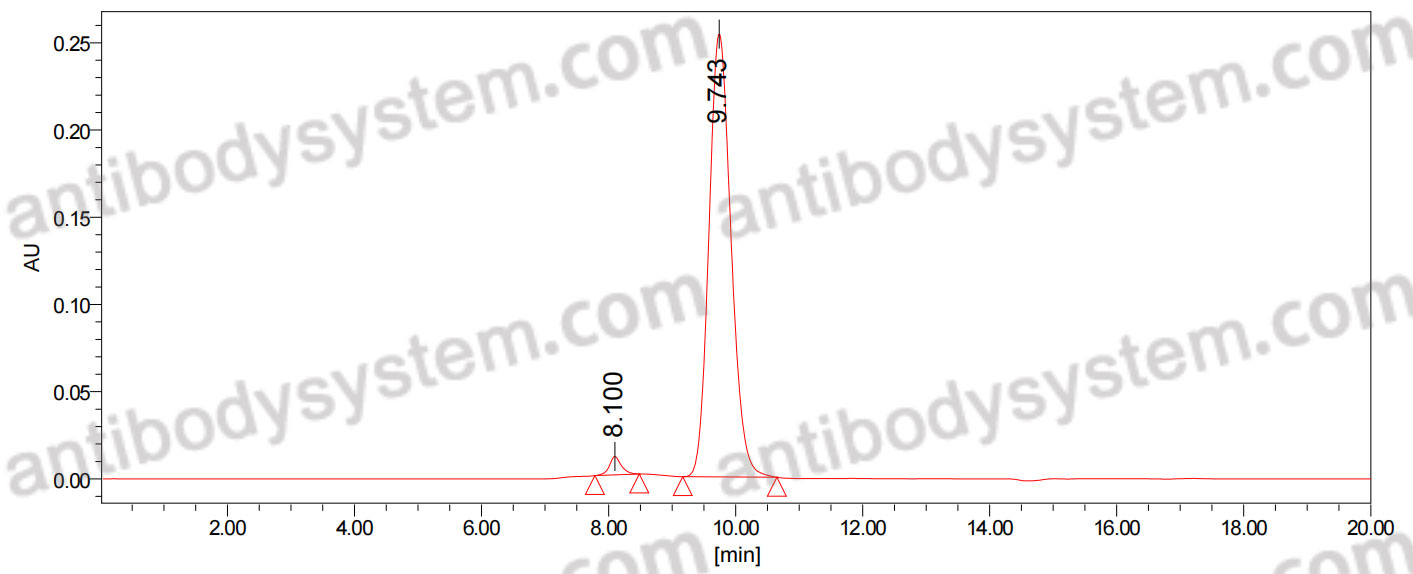Catalog No.
DHF67001
Expression system
Mammalian Cells
Species reactivity
Human
Host species
Human
Isotype
IgG
Clonality
Monoclonal
Target
Opa-interacting protein 4, Preferentially expressed antigen of melanoma, MAPE, OIP-4, Melanoma antigen preferentially expressed in tumors, PRAME, OIP4
Concentration
2.53 mg/ml
Endotoxin level
Please contact with the lab for this information.
Purity
>95% as determined by SDS-PAGE.
Purification
Protein A/G purified from cell culture supernatant.
Accession
P78395
Applications
Research Grade Biosimilar
Form
Liquid
Storage buffer
0.01M PBS, pH 7.4.
Stability and Storage
Use a manual defrost freezer and avoid repeated freeze-thaw cycles. Store at 4°C short term (1-2 weeks). Store at -20°C 12 months. Store at -80°C long term.
Alternative Names
GSK-2302032A, GSK 2302032A, GSK2302032A
Clone ID
GSK 2302032A
Focal High-Grade Areas with a Tumor-in-Tumor Pattern: Another Feature of Pediatric DICER1-Associated Thyroid Carcinoma?, PMID:40448797
Spitz Spindle Cell/Reed Nevus With SQSTM1 :: NTRK2 Fusion and Atypical Features in an Older Male Patient: A Case Report and Review of Literature., PMID:39980385
Characterization of a 3S PRAME VLD-Specific T Cell Receptor and Its Use in Investigational Medicinal Products for TCR-T Therapy of Patients with Myeloid Malignancies., PMID:39858024
An immunohistochemical and molecular genetic study of 60 colorectal carcinoma brain metastases in pursuit of predictive biomarkers for cancer therapy., PMID:39824298
PRAME Immunostaining in BAP-1-Inactivated Melanocytic Tumors: Unraveling Diagnostic Complexity and Exploring Germline Mutation Associations., PMID:39761650
High-affinity T cell receptor ImmTAC® bispecific efficiently redirects T cells to kill tumor cells expressing the cancer-testis antigen PRAME., PMID:39659431
T Cell-Engaging Bispecific Antibodies Targeting gp100 and PRAME: Expanding Application from Uveal Melanoma to Cutaneous Melanoma., PMID:39204391
[Clinicopathological features of metastatic melanoma in effusion cytology of serosal cavity]., PMID:39103266
PRAME and Historical Immunohistochemical Antibodies Ki-67, P16, and HMB-45 in Ambiguous Melanocytic Tumors., PMID:38916203
Utility of next-generation sequencing in the diagnosis of metastatic melanoma: A case report., PMID:38757469
Synergistic enhancement of the mouse Pramex1 and Pramel1 in repressing retinoic acid (RA) signaling during gametogenesis., PMID:38395975
Expression of Melan-A in cutaneous granular cell tumours: a diagnostic pitfall., PMID:37989630
PRAME expression in 137 primary cutaneous melanomas and comparison with 38 related metastases., PMID:37913637
Comparison of Melanocyte-Associated Immunohistochemical Markers in Acral Lentiginous Melanoma and Acral Benign Nevi., PMID:37856738
Immunohistochemistry for PRAME in Dermatopathology., PMID:37856737
Refining the application of PRAME-a useful marker in high CSD and acral melanoma subtypes., PMID:37723345
Diagnostic utility of combining PRAME and HMB-45 stains in primary melanocytic tumors., PMID:37717457
Aminooxy Click Modification of a Periodate-Oxidized Immunoglobulin G: A General Approach to Antibody-Drug Conjugates with Dye-Mediated Expeditious Stoichiometry Control., PMID:36982208
Investigating the inhibitory and penetrating properties of three novel anticancer and antimicrobial scorpion peptides via molecular docking and molecular dynamic simulation., PMID:36927377
PRAME immunohistochemistry can distinguish melanocytic pseudonests of lichenoid reactions from melanoma in situ., PMID:36789669
Branched Linkers for Site-Specific Fluorescent Labeling of Antibodies., PMID:36615611
The role of PRAME and NY-ESO-1 as potential therapeutic and prognostic biomarkers in triple-negative breast carcinomas., PMID:36603407
Role of the bovine PRAMEY protein in sperm function during in vitro fertilization (IVF)., PMID:36527485
PRAME Immunoexpression in 275 Cutaneous Melanocytic Lesions: A Double Institutional Experience., PMID:36140597
Therapeutic targeting of PRAME with mTCRCAR T cells in acute myeloid leukemia., PMID:35984639
PRAME Expression in Cancer. A Systematic Immunohistochemical Study of >5800 Epithelial and Nonepithelial Tumors., PMID:35973038
Preferentially Expressed Antigen in Melanoma Immunohistochemistry Labeling in Uveal Melanomas., PMID:35959159
Genetic mechanism for the loss of PRAME in B cell lymphomas., PMID:35838053
Enhanced stimulation of antigen-specific immune responses against nucleophosmin 1 mutated acute myeloid leukaemia by an anti-programmed death 1 antibody., PMID:35799423
Diagnostic utility of PRAME expression by immunohistochemistry in subungual and non-subungual acral melanocytic lesions., PMID:35794643
Mammalian Display Platform for the Maturation of Bispecific TCR-Based Molecules., PMID:35645207
Case Report: Neuromyelitis Optica After Treatment of Uveal Melanoma With Nivolumab and Ipilimumab., PMID:35402220
PRAME Immunocytochemistry for the Diagnosis of Melanoma Metastases in Cytological Samples., PMID:35328198
Preferentially Expressed Nuclear Antigen in Melanoma Expression in Melanocytic Activation (Melanotic Macule) of the Nail Unit. A Potential Diagnostic Pitfall? A Study of 3 Cases., PMID:35220324
Immunohistochemistry for Preferentially Expressed Antigen in Melanoma in the Differential Diagnosis of Melanocytic Lesions of the Nail Apparatus., PMID:35120028
Sensitive Immunofluorescent Detection of the PRAME Antigen Using a Practical Antibody Conjugation Approach., PMID:34884647
A Systematic Review of Potential Immunotherapies Targeting PRAME in Retinoid Resistant Oral Potentially Malignant Disorders and Oral Cancer., PMID:34711164
HMB45/PRAME, a Novel Double Staining for the Diagnosis of Melanocytic Neoplasms: Technical Aspects, Results, and Comparison With Other Commercially Available Staining (PRAME and Melan A/PRAME)., PMID:34508017
Tumor-associated antigen-specific T cells with nivolumab are safe and persist in vivo in relapsed/refractory Hodgkin lymphoma., PMID:34495306
The expression of multiple cancer/testis antigens can potentially be used to detect circulating disease and clonal evolution in the peripheral blood of multiple myeloma patients., PMID:34462402
The WHO 2018 Classification of Cutaneous Melanocytic Neoplasms: Suggestions From Routine Practice., PMID:34277420
Monoclonal Antibodies to PRAME Protein Slow the Development of PRAME-Expressing Tumor., PMID:34189650
Subcellular localization of the mouse PRAMEL1 and PRAMEX1 reveals multifaceted roles in the nucleus and cytoplasm of germ cells during spermatogenesis., PMID:34074333
Correlation of FISH and PRAME Immunohistochemistry in Ambiguous Superficial Cutaneous Melanocytic Proliferations., PMID:33899766
Immunohistochemical Detection of Cancer-Testis Antigen PRAME., PMID:33890816
Development of a New Highly Selective Monoclonal Antibody against Preferentially Expressed Antigen in Melanoma (PRAME) and Identification of the Target Epitope by Bio-Layer Interferometry., PMID:33804612
Cross-reactivity of NRASQ61R antibody in a subset of Spitz nevi with 11p gain: a potential confounding factor in the era of pathway-based diagnostic approach., PMID:33636207
PRAME immunohistochemistry as an adjunct for diagnosis and histological margin assessment in lentigo maligna., PMID:33280156
PRAME expression in 155 cases of metastatic melanoma., PMID:32939793
Rapid tumor vaccine using Toll-like receptor-activated ovarian cancer ascites monocytes., PMID:32817208


